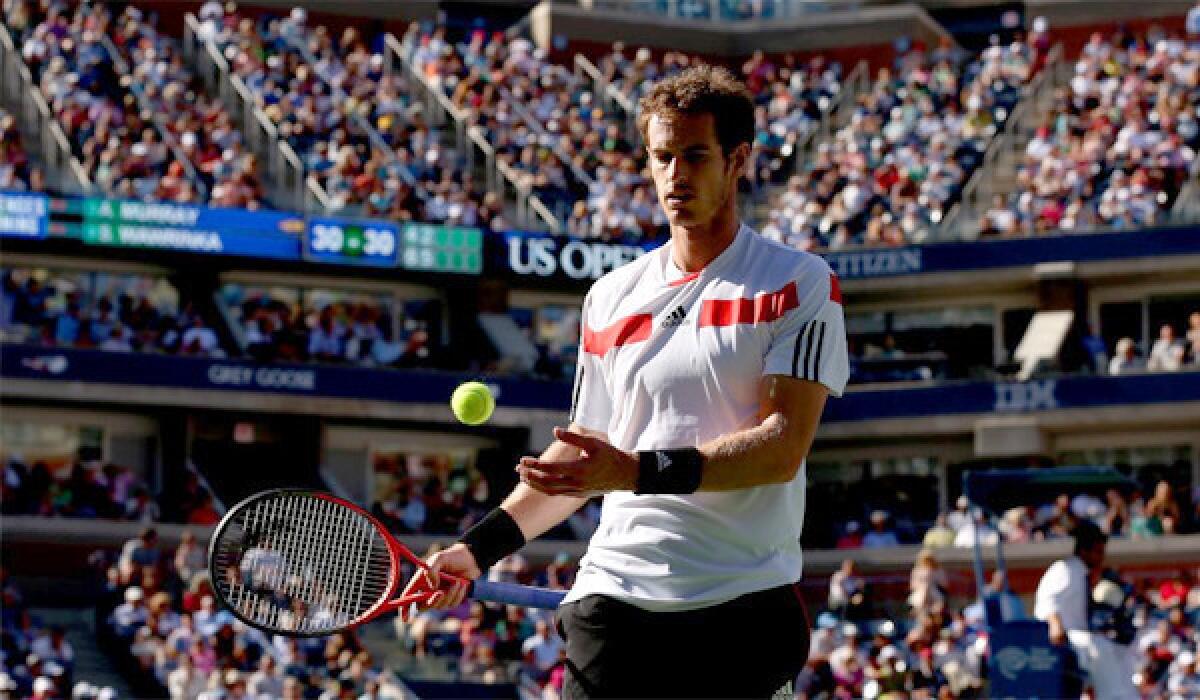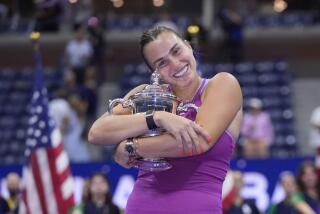Stanislas Wawrinka ushers Andy Murray to the exit at U.S. Open

- Share via
NEW YORK — Andy Murray found out.
Defending a Grand Slam championship is not easy.
From the start of the U.S. Open, Murray never seemed at his best. He needed four sets to eliminate undistinguished Denis Istomin of Uzbekistan in the fourth round, and afterward a soft-spoken Murray had little to say about his win.
Thursday, ninth-seeded Stanislas Wawrinka reached his first major semifinal with a thorough beating of the third-seeded and defending champion Murray, 6-4, 6-3, 6-2, on Arthur Ashe Stadium court.
Top-seeded Novak Djokovic, who had called his play “flawless” in the quarterfinals, got into a groundstroke street fight Thursday night and lost his first set of the tournament before recovering to beat 21st-seeded Russian Mikhail Youzhny. Djokovic, winner of six majors, including the 2011 U.S. Open, finally eliminated the 31-year-old Youzhny, 6-3, 6-2, 3-6, 6-0.
Djokovic will play Wawrinka in Saturday’s semifinals. Second-seeded Rafael Nadal of Spain will face eighth-seeded Frenchman Richard Gasquet in the other semifinal.
Wawrinka — who’s from Switzerland, but isn’t the Swiss man expected to advance this far — played tennis as if he were floating above the court, hovering and ready to pounce on anything short of the baseline as a cranky Murray broke a racket after losing the first set.
Murray could never find the range with his vaunted service return, and Wawrinka was sending balls back so fast that Murray was left flat-footed and almost unable to move as shots flew past him.
Murray ruined another racket after losing the second set, when he also let out a scream and gestured to his coach, Ivan Lendl, who sat stone-faced.
Later, an emotionless Murray said he would have liked to have played better. “I’ve had a good run the last couple of years. It’s a shame I had to play a bad match today.”
Wawrinka, in contrast, said, “It feels amazing for sure, especially here. Especially after this match. He’s the defending champion. He’s a tough opponent.”
It had seemed that Murray, of Britain, had replaced Federer as part of a trio of unbeatables, that included Djokovic and Nadal. But his earliest exit from the Open since 2010 shows he has some work to do.
He did say it has been a long, tough road since winning the Olympics and U.S. Open in 2012 and Wimbledon this year.
“When you work hard at something for a lot of years, it’s going to take time to fire yourself up and get to training 110%,” Murray said. “That’s something kind of natural after winning Wimbledon.”
Despite occasionally tugging at his back, Murray said a simple “No” when asked if he was suffering any injury or pain there.
And within an hour of his loss, Murray was packing up his car to make his escape from Queens.
It was 18 months ago that Murray rejuvenated his career by hiring Lendl, who helped the Scottish star win his first Grand Slam titles. This past spring, Wawrinka turned to a new advisor as well, beginning work with Swede Magnus Norman, a former ATP player.
Norman said he always believed Wawrinka had the right mentality to be a top player but that it was hard to live in the shadows of fellow Swiss star Roger Federer.
“It’s not easy, but I knew Stan had this in him,” Norman said. “He’s shown in the past, on and off, that he has it. I think I’ve given him a little more self-belief. Having a good team around you matters because he still doesn’t always believe in himself.”
Norman said that Wawrinka seemed to shy away from greatness. “We’re in an era with guys who are probably some of the best ever,” he said. “Stan has beaten Andy in the past. But he wasn’t unbeatable, especially this week when Stan was playing so well and Andy seemed to be struggling.”
Meanwhile, Djokovic, a 26-year-old Serb, said his play wasn’t as clean as in the fourth round.
“I tried to regroup after the third set, focus on every point individually and start playing the game I had in the first two sets,” he said. “It had suddenly changed. For some reason I allowed him to come back into the match, started to push the ball, being more passive.
“It was important to get the early break in the fourth and I did that, and after that I felt a big relief.”
Twitter: @mepucin
More to Read
Go beyond the scoreboard
Get the latest on L.A.'s teams in the daily Sports Report newsletter.
You may occasionally receive promotional content from the Los Angeles Times.










